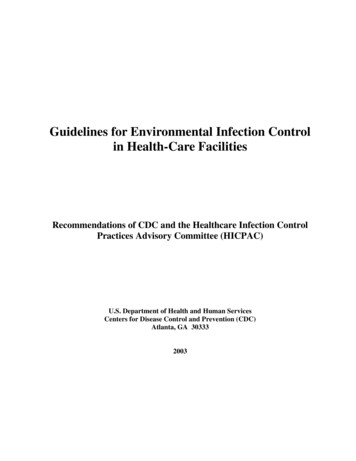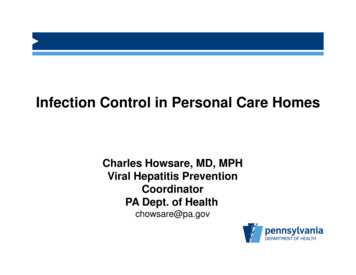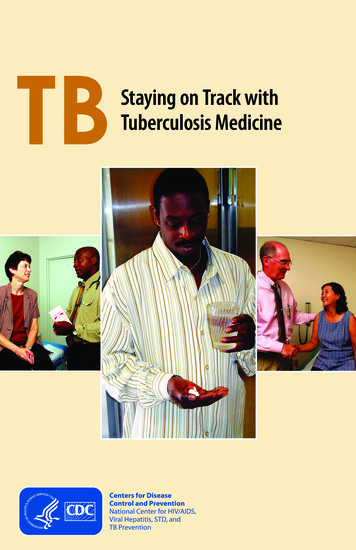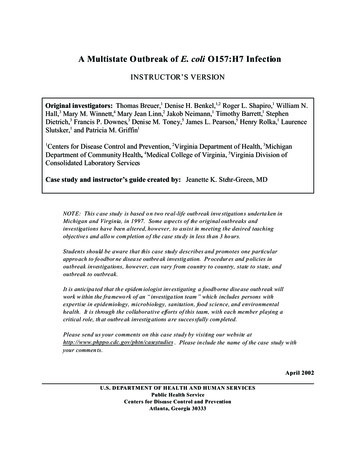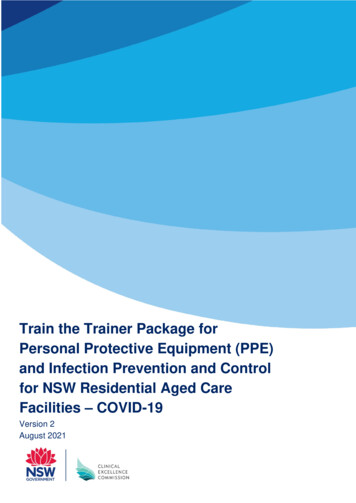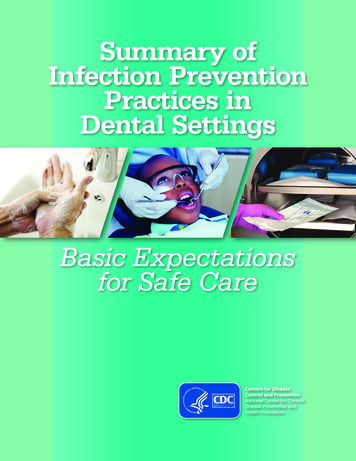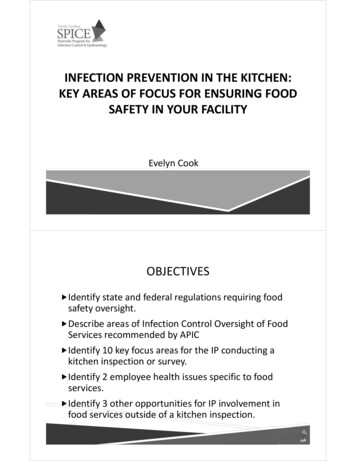
Transcription
OSAP/DQPBEST PRACTICES FOR INFECTIONCONTROL IN DENTAL CLINICS DURINGTHE COVID-19 PANDEMICOSAP.The Safest Dental Visit" 0;gDentaQues1:: EPartnershipfor Oral Health AdvancementRevised 6/19/2020
CONTENTSINTRODUCTION. 4RATIONALE. 4HOW TO USE THIS RESOURCE. 6PREPARING THE DENTAL CLINIC FOR PATIENTS AND VISITORS CHECKLIST . 6PART 1: PREPARING THE DENTAL CLINIC PRIOR TO PATIENT APPOINTMENTS. 7POLICIES AND PROCEDURES . 7DENTAL TEAM PREPARATION AND SCREENING. 8EQUIPMENT AND SUPPLIES. 9ADJUSTING CLINICAL AREAS. 10HEATING, VENTILATION, AND AIR CONDITIONING (HVAC). 10ENTRYWAY AND LOBBY AREA PREPARATION. 10UNIVERSAL SOURCE CONTROL . 11PATIENT/VISITOR COMMUNICATION AND PRE-APPOINTMENT SCREENING. 11PART 2: DELIVERING SAFE PATIENT CARE. 12PATIENT ARRIVAL FOR APPOINTMENT. 12DENTAL OPERATORY SPECIFICS FOR PATIENT CARE(TARGETED TO DENTISTS, ASSISTANTS, HYGIENISTS) . 12PERSONAL PROTECTIVE EQUIPMENT FOR THE CLINICAL TEAM . 13PATIENT DISCHARGE. 13ENVIRONMENTAL INFECTION CONTROL . 14REFERENCES . 14RESOURCES AND TOOLS. 15WEBSITE RESOURCES . 15COVID-19 PATIENT TRIAGE QUESTIONS . 18RESPIRATORY PROTECTION PLAN IMPLEMENTATION CHECKLIST . 19DENTAL PPE DONNING/DOFFING CHECKLIST . 20DAILY EMPLOYEE SCREENING LOG . 212 June 2020 by the Organization for Safety, Asepsis and Prevention (OSAP)and the DentaQuest Partnership for Oral Health Advancement (DQP)
Prepared by the Organization for Safety, Asepsis and Prevention(OSAP) through an educational grant by the DentaQuestPartnership for Oral Health Advancement (DQP)Editor in Chief: Karen Gregory, RNExecutive Director: Michelle Lee, CPCDentaQuest Partnership Liaison: Julie Frantsve-Hawley, PhDSubject Matter Experts: Leslie Canham, CDA, RDA, CSP; Karen Daw,MBA, CECM; Nancy Dewhirst, RDH, BS; Jackie Dorst, RDH; Kathy Eklund,RDH, MHP; Marie Fluent, DDS; Linda Harvey, RDH, MS; Michele Lash,RDH; Kelli Mack, DDS; John Molinari, PhD; Joyce Moore, RDH, BSDH,CRCST; Patricia Reynolds, CRDH, BASDH; Douglas Risk, DDS, ABGD;Katherine Schrubbe, RDH, BS, MEd, PhD; Michelle Strange, MSDH, RDHCopy Editor: Therese Long, MBA, CAEDISCLOSURE OF RELATIONSHIPThe subject matter experts engaged in this project disclose that theyhave no financial interests or other relationships with the manufactureof commercial products, providers of commercial services, orcommercial supporters that influence the content of this resource.DISCLAIMERThis compilation is intended to provide useful information to dentists and theirteam members regarding practical guidance for dental infection preventionand control during a pandemic including COVID-19. This information is by itsnature general and is not a substitute for actual professional advice based upona practice’s or individual practitioner’s unique facts and circumstances. Whilewe have made every effort to ensure that this information has been obtainedfrom trustworthy sources, neither the Organization for Safety, Asepsis andPrevention (OSAP) nor DentaQuest Partnership for Oral Health Advancement(DQP) has responsibility for any errors or omissions or for any results obtainedfrom using this information. This Information does not constitute legal or otherprofessional advice. You should always consult with your own professionaladvisors. With respect to any links or references OSAP and DQP have includedto any third party’s website(s) or publication(s), neither OSAP nor DQP isendorsing their content nor does either organization make any representationsor warranties about the information provided on those sites. In no eventwill OSAP or DQP or its affiliates be liable to you or any third party for anydecision made or action taken based on the information in this compilation. June 2020 by the Organization for Safety, Asepsis and Prevention (OSAP)and the DentaQuest Partnership for Oral Health Advancement (DQP)3
INTRODUCTIONAs the COVID-19 pandemic, caused by the virus SARS-CoV-2, continues to evolve, dental practicesare beginning to schedule nonemergency dental care. Establishing an infection control plan thatplaces patient and staff safety first is the rationale behind this new best practices resource.This best practices resource is a compilation of current regulations, guidance and practice tips assembled bynational and international dental infection prevention experts. These leaders completed an extensive review ofguidance provided by agencies such as the Centers for Disease Control and Prevention (CDC), the OccupationalSafety and Health Administration (OSHA), the American Dental Association (ADA), the American Dental Hygienists’Association (ADHA) and others, and developed straightforward instructions addressing all the major aspects of safelyengaging in dental practice during the COVID-19 pandemic. Developed for dental clinicians, front office staff andother personnel, this document has two sections, a practical checklist and a companion resources/tools section.Because COVID-19 is still a very real pandemic, it is important for dentistry to: Regularly consult state dental boards and state or local health departments for current local information for requirements specific totheir jurisdictions, including recognizing the degree of community transmission and impact, and their region-specific recommendations. Use professional judgement in situations where there is not specific guidance or regulation with the goal of patient and personnel safety. Understand that these best practices will continue to be updated as the pandemic evolves.RATIONALEThe dental profession is categorized by OSHA as overall a “Very High Risk” category. This assessment is due tothe potential for exposure to known or suspected sources of SARS-COV-2 during specific aerosol-generatingprocedures (AGPs). AGPs may include, in dentistry, procedures using high and low speed handpieces, ultrasonicscalers, air/water syringes and air polishing. OSHA further designated risk levels broken down by task.iDENTISTRY WORK TASKS ASSOCIATED WITH EXPOSURE RISK LEVELSMEDIUM RISKLOW RISK Performing administrative duties in non-public areasof dental facilities, away from other staff members. Providing urgent or emergency dental care, not involvingAGPs to well patients (i.e., to members of the general publicwho are not known or suspected COVID-19 patients). Working in busy staff work areas.HIGH RISKVERY HIGH RISK Entering a known or suspected COVID-19 patient’s care area. Performing AGPs on known or suspected COVID-19 patients. Providing emergency dental care, not involving AGPs,to known or suspected COVID-19 patients. Collecting or handling specimens from knownor suspected COVID-19 patients. Performing AGPs on well patients.This best practices resource is designed to help reduce the level of risk from “very high” through a hierarchy of safetyprotocols that have the greatest impact on clinical safety.ii Following is a graphic of a Hierarchy of Controls developedby CDC’s National Institute for Occupational Safety and Health (NIOSH). The pyramid moves from the most effectivecontrols down to the least effective. Note the dental examples (not a complete list) for each level of control.4 June 2020 by the Organization for Safety, Asepsis and Prevention (OSAP)and the DentaQuest Partnership for Oral Health Advancement (DQP)
HIERARCHY OF CONTROLS WITH DENTAL EXAMPLESPHYSICALLY REMOVE THE HAZARDELIMINATION Symptom screening prior to appointment andon arrival: isolate and eliminate (discharge, refer)all symptomatic patients and workers Viral testing at time of treatment – Not currently available Remove items and surfaces that might crosscontaminate and replace with non-touch optionsREPLACE THE HAZARDSUBSTITUTIONMostEffective Remotely assist patients through TeledentistryAlter or postpone treatment plan if this does not harm patientPrioritize at-risk population in most need of dental careLimit close contact of patients throughout the practiceAvoid aerosolizing procedures, substitute withnon/low spray practices where possible Re-assign roles of high risk personnel tolow exposure work or locationsISOLATE PEOPLE FROM THE HAZARDENGINEERINGCONTROLS Facility space organization into infection control zones.Isolate and separate space with physical barriers Rubber dam isolation use High volume evacuation in conjunction with isolation Pre-procedure mouth rinse to reduce microorganisms Hand instrumentation for hygiene, non-surgicalperiodontal treatment, minimal restorative treatmentCHANGE THE WAY PEOPLE WORKADMINISTRATIVECONTROLS Respiratory hygiene/cough etiquette/hand hygiene stationsSick leave policiesManage visitors, limit points of entryAdjustments in appointment schedulingUniversal Source Control – all people wearappropriate level face coverings in facility Create, train new employee roles Respiratory Protection Program (RPP)PROTECT THE WORKER FROM THE HAZARDPPE GownsGlovesMaskFace shieldGogglesN95 respiratorLeastEffective June 2020 by the Organization for Safety, Asepsis and Prevention (OSAP)and the DentaQuest Partnership for Oral Health Advancement (DQP)5
HOW TO USE THIS RESOURCE:This resource is intended for all Dental Health Care Personnel (DHCP) including all paid and unpaid personnelin the dental health-care setting who might be occupationally exposed to infectious materials, including bodysubstances and contaminated supplies, equipment, environmental surfaces, water, or air. This includes dentists,dental hygienists, dental assistants, dental laboratory technicians (in-office and commercial), students andtrainees, contractual personnel, other persons not directly involved in patient care but potentially exposedto infectious agents (e.g., administrative, clerical housekeeping, maintenance, or volunteer personnel).iiiDHCP are encouraged to use this resource to ensure their practice setting has the appropriateinfection prevention policies and practices in place, including relevant training and education andadequate supplies to provide safe care and a safe working environment during a pandemic.-PREPARING THE DENTAL CLINIC FORPATIENTS AND VISITORS CHECKLISTThis checklist includes two major sections:1) preparing the clinic prior to patient appointments, and2) delivering safe patient care.DHCP are encouraged to review each item to check “yes” upon completion of the action item or policy or N/Aif the item does not apply to the practice. A source column indicates where the guidance item was obtainedincluding CDCiv (Centers for Disease Control and Prevention), OSHAv (Occupational Safety and HealthAdministration), ADAvi (American Dental Association) and ADHAvii (American Dental Hygienists’ Association).When “ALL” is used in the source column, it indicates that CDC, OSHA, ADA and ADHA offer the same guidance.Note that the situation is evolving, and this checklist will be updated as new guidance is available.6 June 2020 by the Organization for Safety, Asepsis and Prevention (OSAP)and the DentaQuest Partnership for Oral Health Advancement (DQP)
PART 1: PREPARING THE DENTAL CLINIC PRIORTO PATIENT APPOINTMENTSPOLICIES AND PROCEDURESTasks associated with different exposure risk levels have been identifiedYES N/ASOURCEOSHAWritten policies have been developed and implemented that address at least the following: Process monitor daily the prevalence of COVID-19 at the community and state level.ALL Local health department directory State health department directory Treatment of suspected or confirmed COVID-19 positive patient whichwould require the use of aerosol-generating procedures.ALL Plan has been created to complete the procedure in an Airborne Illness IsolationRoom (AIIR) with all in attendance utilizing a N95 respirator or higher. Universal Source Control requiring everyone entering the office, regardless of whetherthey have COVID-19 symptoms to wear appropriate level of mask or a face covering.CDC, OSHA,ADHA Patient and visitors are encouraged to wear their own personal mask. Maskswill be provided, if supplies are adequate, for patients and visitors. Every employee will always wear facemasks when in the dental setting. Cloth masks may be utilized by staff not involved in direct patient care activities. Clinical staff can utilize a cloth face mask when not involved in direct patient care. Facemasks or cloth masks should be replaced if they become hard to breathe through,wet or soiled. Hand hygiene should be performed anytime masks are adjusted or removed. Minimizing the number of people accompanying patient. Actively screening employees, patients and visitors for fever and other symptoms of COVID-19before they enter the dental setting. (See COVID-19 Patient Triage Questions in Resources/Toolssection of this document.) Maintaining six-foot social distancing at work with other teammembers and patients when not performing treatment.CDC, ADA,ADHAALLALL Work-exclusion policy to ensure DHCP understand: DHCP should stay home if sick or showing cold, flu or COVID-19 symptoms. All DHCP are screened for COVID-19 at the beginning of the day (See EmployeeScreening Log for COVID-19 in Resources/Tools section of this document) If DHCP develop fever (T 100.0 F) or symptoms consistent with COVID-19while at work, workers should be reminded to keep their mask on, are senthome and asked to seek medical care. Workplace exposures to COVID-19 will be managed based on Interim US Guidance for RiskAssessment and Work Restrictions for Healthcare Personnel with Potential Exposure. Return to work date will be based on Criteria for Return to Work for HealthcarePersonnel with Suspected or Confirmed COVID-19 (Interim Guidance). Written Respiratory Protection Program which addresses training, medical evaluationand fit testing when N95 or higher respirators are used for clinical care. (See RPPImplementation Checklist in Resources/Tools section of this document.) June 2020 by the Organization for Safety, Asepsis and Prevention (OSAP)and the DentaQuest Partnership for Oral Health Advancement (DQP)CDC, OSHA,ADHA7
̚ PRACTICE TIPSĉ Consider having team members participate in ADA/OSAP webinar “COVID-19 Response: CDC Guidance for Dental Settings (May 2020)”ĉ Conduct a mock opening in which all team members practice/rehearse new routines. Areas of consideration:Ċ Staff flow during workday: determine how breaks will occur taking into consideration social distancingĊ Patient flow entrance and exitĊ Screening of personnelĊ Screening of patientsĊ Review of aerosol reduction techniquesĊ Donning and doffing of PPE (See Dental PPE Donning/Doffing Checklist on page 20)Ċ Importance of frequent, correct hand hygieneĊ Environmental surface asepsis including cleaning and disinfection of clinical contact surfaces and housekeeping surfacesĉ Conduct team meetings to discuss:Ċ Training employees on SARS-CoV-2, updated or new policies and new roles and responsibilities to reduce the risk of exposureĊ Community transmission of COVID-19 in the area. NOTE: if there is a surge of COVID-19, reconsider decision to engage in practice.Ċ Current PPE supplies and other infection control supplies needed. NOTE: if adequate supplies are not available,reconsider the decision to engage in practice.Ċ Strategies for social distancing among patients and dental team.Ċ Assignments of specific duties related to safe practices. NOTE: see next section of this checklist for additional details.Ċ Methods to minimize aerosol production in the office.Ċ The content of the facility’s written Respiratory Protection Program, which must be implementedwhen respirators are in use. (See RPP Implementation Checklist on page 19)Ċ Q&A session to address challenges employees have identified.DENTAL TEAM PREPARATION AND SCREENINGAll team members answer COVID-19 screening questions and have their temperatures takenwith a contactless thermometer. NOTE: 100.0 F for DHCP. Results are recorded daily. SeeEmployee Screening Log for COVID-19 in Resources and Tools section of this document.DHCP who show signs and symptoms of COVID-19 are isolated from othersbefore being sent home and referred to medical provider or emergent care.Symptomatic healthcare workers are at high priority for COVID-19 testing.Pregnant personnel are instructed to: Seek and follow medical guidance regarding work. Avoid people who are sick or who have been exposed to the virus. Consider limiting exposure to suspected or confirmed COVID-19 patientsespecially during higher risk exposures (aerosol-generating procedures).̚ PRACTICE TIPSĉ For DHCP who are 65 years or older, or immunocompromised and may be at higher risk forCOVID-19 disease consider obtaining a medical evaluation before returning to work.ĉ Every member of the dental team should receive the seasonal influenza vaccine.8 June 2020 by the Organization for Safety, Asepsis and Prevention (OSAP)and the DentaQuest Partnership for Oral Health Advancement (DQP)YES N/ASOURCEALLCDC, ADA,ADHA
EQUIPMENT AND SUPPLIESYES N/AAll manufacturers’ Instructions for Use (IFU) have been gathered and reviewed for how to“re-start” equipment that has not been in use including any required routine maintenance.The ultrasonic instrument cleaner has been prepared for use by cleaning,degassing (no instruments in the tank) and by performing a cavitationtest (aluminum foil test or other cavitation test method).The instrument washer has been prepared for use based on manufacturer’s IFU.The autoclave has been prepared by cleaning it, examining filters and gaskets, andreplacing if indicated and running empty sterilization cycles with spore tests per themanufacturer’s IFU in sufficient time to obtain spore test results prior to re-opening.Dental unit waterlines: Have been shocked and prepared for use based on manufacturer’s IFUSOURCECDCCDC, ADHACDC, ADHACDC, ADHACDC, ADA,ADHA Testing has been completed with sufficient time to obtain results toensure the lines meet the standard for safe drinking water based on theEnvironmental Protection Agency (EPA) standard of 500 CFU/mLHigh-volume evacuators (HVE) are available in all dental treatment rooms.Perform maintenance per manufacturer’s IFU for proper maintenance afterextended storage on other items including air compressor, vacuum and suctionlines, amalgam separator, radiology equipment and any other equipment.CDC, ADA,ADHACDC, ADHA̚ PRACTICE TIPS Store all product/equipment IFUs either in an electronic or hard-copy format so that the information is easily accessible. Perform any required routine maintenance for all equipment. Document all equipment testing and maintenance procedures. For mail-in spore testing and/or dental unit waterline testing perform at least seven (7) daysin advance of opening to ensure adequate time to receive test results. Inspect supplies and equipment to ensure that none have expiration dates that havepassed. Suggested items to consider (not a complete list): Emergency kit All medications Materials used during patient treatment Supplies used for the sterilization process (sterilization pouches, chemical indicators, spore tests) Personal Protective Equipment Surface disinfectants/high level disinfectants Dispose expired products properly as recommended by the appropriate government entity(EPA, Drug Enforcement Administration [DEA], local waste management) June 2020 by the Organization for Safety, Asepsis and Prevention (OSAP)and the DentaQuest Partnership for Oral Health Advancement (DQP)9
ADJUSTING CLINICAL AREASYES N/ASOURCEFor clinics with open floor plans consider installing floor to ceiling barriers(ensuring they do not interfere with fire sprinklers) to enhance the effectivenessof any heating, ventilation and air conditioning air filtration systems utilized.CDCIf there is no door for the operatory, or the treatment area lacks complete walls, consider usinga plastic barrier to seal the room. This barrier will need to be disinfected between patients.ADHAWhen possible, orient operatories parallel to the direction of airflow.CDCHEATING, VENTILATION, AND AIR CONDITIONING (HVAC)YES N/AA HVAC professional has been contacted to determine strategies to reduceexposure to the virus based on CDC guidance. Areas to consider:SOURCECDC Increasing filtration efficiency to the highest level compatible with the HVAC system.CDC, OSHA Ability to safely increase the percentage of outdoor air supplied through the HVAC system.CDC Limiting the use of demand-controlled ventilation, such as leaving thefan running, including bathroom exhaust fans during work hours, andwhen feasible, up to two hours after the end of the workday.CDC Appropriate use/placement of a portable HEPA air filtration unit while the patient isactively undergoing, and immediately following, an aerosol-generating procedure.CDC Use of upper-room ultraviolet germicidal irradiation (UVGI) as an additional solution.CDCENTRYWAY AND LOBBY AREA PREPARATIONYES N/ASOURCESignage has been placed to encourage hand hygiene, respiratory hygiene,and cough etiquette.Hand hygiene products, tissues and waste cans are placed for patient and visitor use.ALLSneeze guards/plastic barriers are in place at Reception/Check-out andother areas where potential exposures may occur.Chairs in the waiting room have been placed at least six (6) feet apart.ALLHigh touch items such as magazines, toys, coffee machines and remote-control deviceshave been removed.̚ PRACTICE TIPConsider designating an area for delivery of packages which do not require signatures.10 June 2020 by the Organization for Safety, Asepsis and Prevention (OSAP)and the DentaQuest Partnership for Oral Health Advancement (DQP)ALLCDC, ADA,ADHACDC, ADA,ADHA
UNIVERSAL SOURCE CONTROLYES N/AUniversal Source Control measures have been implemented to reduceexposure to potentially infectious co-workers or visitorsSOURCECDC, ADHA All employees will always wear facemasks when in the dental setting. Cloth masks may be utilized by non-clinical staff for source control. Surgical masks or respirators provide a higher level of protection and arerequired when performing patient clinical procedures. When not involved in directpatient care, clinical staff can utilize a cloth mask for source control.̚ PRACTICE TIPS If facemasks or cloth masks become hard to breathe through, wet or soiled, they should be replaced. Hand hygiene should be performed anytime masks are adjusted or removed.PATIENT/VISITOR COMMUNICATION AND PRE-APPOINTMENTSCREENINGAn area near the entry to the office has been identified in which to screen patients.NOTE: Consider screening patients outside of the office when possible.There are adequate supplies of PPE dedicated to the screening process includingmasks, eye protection, gloves, and gowns. NOTE: If supplies are sufficient ensure thelowest level medical masks are provided for those patients who arrive without a mask.Appropriate screening supplies have been assembled for the screening processincluding clip board, thermometer, etc.Prior to the dental appointment patients are telephoned to:YES N/ASOURCEALLALLALL Triage and assess their dental condition. Screen for COVID-19 symptoms. Request patients to limit the number of accompanying visitors. Advise patients that: they and any accompanying visitor will need to wear a mask andlimit bringing personal belongings into the office. an additional COVID-19 symptom screening will occur upon their arrival to the appointment. they may be asked to wait in a personal vehicle or outside the dental facility wherethey can be contacted by mobile phone when it is their turn for dental care.̚ PRACTICE TIPSUse Teledentistry (e.g., voice or video) for non-emergency consultations when possible. June 2020 by the Organization for Safety, Asepsis and Prevention (OSAP)and the DentaQuest Partnership for Oral Health Advancement (DQP)11
PART 2: DELIVERING SAFE PATIENT CAREThe following sections of the checklist address the care of the patient, and processes related to providingoral healthcare safely, beginning with patient arrival to the office to patient discharge with subsequentdecontamination of the operatory. The appropriate use of PPE is listed in the context of delivery of patient care.PATIENT ARRIVAL FOR APPOINTMENTYES N/APatients and anyone accompanying them to the appointment are appropriately screenedfor temperature and signs/symptoms of COVID-19 prior to entering the office:SOURCEALL When possible escorts, friends or other family members donot enter the waiting room or treatment areas. All patients and visitors are reminded to keep face coveringson if possible, except during treatment. All patients and visitors are directed to perform hand hygiene when entering the clinic. Physical distancing between patients is limited by spacing of chairs in thelobby area and monitoring of patient flow through the practice. Patients who have a temperature ( 100.4 F) and/or signs and symptoms of COVID-19 areprovided a mask if they are not wearing one and asked to follow-up with their healthcareprovider. For an elevated temperature alone, the dentist is consulted for further evaluation.̚ PRACTICE TIPSĉ Ensure patients’ face coverings cover both the nose and mouth.ĉ Advise the patient to notify the clinic if they develop symptoms of COVID-19 within 48-hours of their appointment.ĉ If the patient has a temperature, the advice to go home and follow-up with their personal healthcare provider may be the mostcommon response, but fever either subjective or confirmed could be an indication of a dental issue that should be furtherevaluated. If the patient has a fever strongly associated with a dental diagnosis (e.g., pulpal and periapical dental pain and intraoralswelling), but no other symptoms consistent with COVID-19 are present, care can be provided with appropriate protocols.viiiĉ Further evaluation can occur using Telehealth technologies.DENTAL OPERATORY SPECIFICS FOR PATIENT CARE(TARGETED TO DENTISTS, ASSISTANTS, HYGIENISTS)The dental operatory is prepared to resume care in the era ofCOVID-19. Preparations may include designating a: Clean area for preparation of trays to be used during patient care. Include single-usedisposable items (e.g., gauze, cotton rolls, HVE tips, saliva ejectors) and supplies for thedelivery of dental materials (items necessary for direct and indirect restorative procedures).Other supplies and instruments should be in covered storage during the procedure. Area(s) outside of the operatory where PPE can be donned and doffed appropriately and safely.Aerosol-generating procedures are avoided whenever possible.YES N/ASOURCECDC, ADA,ADHACDCCDC, ADA,ADHAALL Prioritize hand instrumentation. Avoid/minimize the use of handpieces, lasers, air/water syringes, airpolishing and ultrasonic scalers unless medically necessary. Use rubber dams and high volume evacuation High-volume evacuators available for all members of the dental team̚ PRACTICE TIPConsider reassigning roles for DHCP at high risk of adverse outcomes from COVID-19 to low exposure work or locations.12 June 2020 by the Organization for Safety, Asepsis and Prevention (OSAP)and the DentaQuest Partnership for Oral Health Advancement (DQP)
PERSONAL PROTECTIVE EQUIPMENT FOR THE CLINICAL TEAMYES N/AThe appropriate amount of PPE is available to support anticipated patient volume.SOURCECDC, ADA,ADHA When supplies are limited prioritize dental care for those with the highest need. Decisions on strategies to optimize supplies of limited PPE is based on theCDC Strategies to Optimize the Supply of PPE and Other EquipmentRespiratory protection strategies have been documented.CDC, ADA,ADHA During aerosol-generating procedures N95 respirators, or respiratorsthat of
Jun 19, 2020 · June 2020 by the Organization for Safety, Asepsis and Prevention (OSAP) and the DentaQuest Partnership for Oral Health Advancement (DQP) HI
